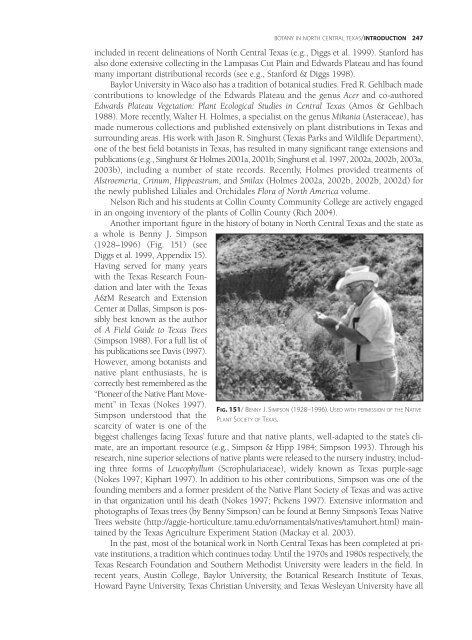ILLUSTRATED FLORA OF EAST TEXAS - Brit - Botanical Research ...
ILLUSTRATED FLORA OF EAST TEXAS - Brit - Botanical Research ...
ILLUSTRATED FLORA OF EAST TEXAS - Brit - Botanical Research ...
You also want an ePaper? Increase the reach of your titles
YUMPU automatically turns print PDFs into web optimized ePapers that Google loves.
included in recent delineations of North Central Texas (e.g., Diggs et al. 1999). Stanford has<br />
also done extensive collecting in the Lampasas Cut Plain and Edwards Plateau and has found<br />
many important distributional records (see e.g., Stanford & Diggs 1998).<br />
Baylor University in Waco also has a tradition of botanical studies. Fred R. Gehlbach made<br />
contributions to knowledge of the Edwards Plateau and the genus Acer and co-authored<br />
Edwards Plateau Vegetation: Plant Ecological Studies in Central Texas (Amos & Gehlbach<br />
1988). More recently, Walter H. Holmes, a specialist on the genus Mikania (Asteraceae), has<br />
made numerous collections and published extensively on plant distributions in Texas and<br />
surrounding areas. His work with Jason R. Singhurst (Texas Parks and Wildlife Department),<br />
one of the best field botanists in Texas, has resulted in many significant range extensions and<br />
publications (e.g., Singhurst & Holmes 2001a, 2001b; Singhurst et al. 1997, 2002a, 2002b, 2003a,<br />
2003b), including a number of state records. Recently, Holmes provided treatments of<br />
Alstroemeria, Crinum, Hippeastrum, and Smilax (Holmes 2002a, 2002b, 2002b, 2002d) for<br />
the newly published Liliales and Orchidales Flora of North America volume.<br />
Nelson Rich and his students at Collin County Community College are actively engaged<br />
in an ongoing inventory of the plants of Collin County (Rich 2004).<br />
Another important figure in the history of botany in North Central Texas and the state as<br />
a whole is Benny J. Simpson<br />
(1928–1996) (Fig. 151) (see<br />
Diggs et al. 1999, Appendix 15).<br />
Having served for many years<br />
with the Texas <strong>Research</strong> Foundation<br />
and later with the Texas<br />
A&M <strong>Research</strong> and Extension<br />
Center at Dallas, Simpson is possibly<br />
best known as the author<br />
of A Field Guide to Texas Trees<br />
(Simpson 1988). For a full list of<br />
his publications see Davis (1997).<br />
However, among botanists and<br />
native plant enthusiasts, he is<br />
correctly best remembered as the<br />
“Pioneer of the Native Plant Move-<br />
ment” in Texas (Nokes 1997).<br />
Simpson understood that the<br />
scarcity of water is one of the<br />
BOTANY IN NORTH CENTRAL <strong>TEXAS</strong>/INTRODUCTION 247<br />
FIG. 151/ BENNY J. SIMPSON (1928–1996). USED WITH PERMISSION <strong>OF</strong> THE NATIVE<br />
PLANT SOCIETY <strong>OF</strong> <strong>TEXAS</strong>.<br />
biggest challenges facing Texas’ future and that native plants, well-adapted to the state’s climate,<br />
are an important resource (e.g., Simpson & Hipp 1984; Simpson 1993). Through his<br />
research, nine superior selections of native plants were released to the nursery industry, including<br />
three forms of Leucophyllum (Scrophulariaceae), widely known as Texas purple-sage<br />
(Nokes 1997; Kiphart 1997). In addition to his other contributions, Simpson was one of the<br />
founding members and a former president of the Native Plant Society of Texas and was active<br />
in that organization until his death (Nokes 1997; Pickens 1997). Extensive information and<br />
photographs of Texas trees (by Benny Simpson) can be found at Benny Simpson’s Texas Native<br />
Trees website (http://aggie-horticulture.tamu.edu/ornamentals/natives/tamuhort.html) maintained<br />
by the Texas Agriculture Experiment Station (Mackay et al. 2003).<br />
In the past, most of the botanical work in North Central Texas has been completed at private<br />
institutions, a tradition which continues today. Until the 1970s and 1980s respectively, the<br />
Texas <strong>Research</strong> Foundation and Southern Methodist University were leaders in the field. In<br />
recent years, Austin College, Baylor University, the <strong>Botanical</strong> <strong>Research</strong> Institute of Texas,<br />
Howard Payne University, Texas Christian University, and Texas Wesleyan University have all
















